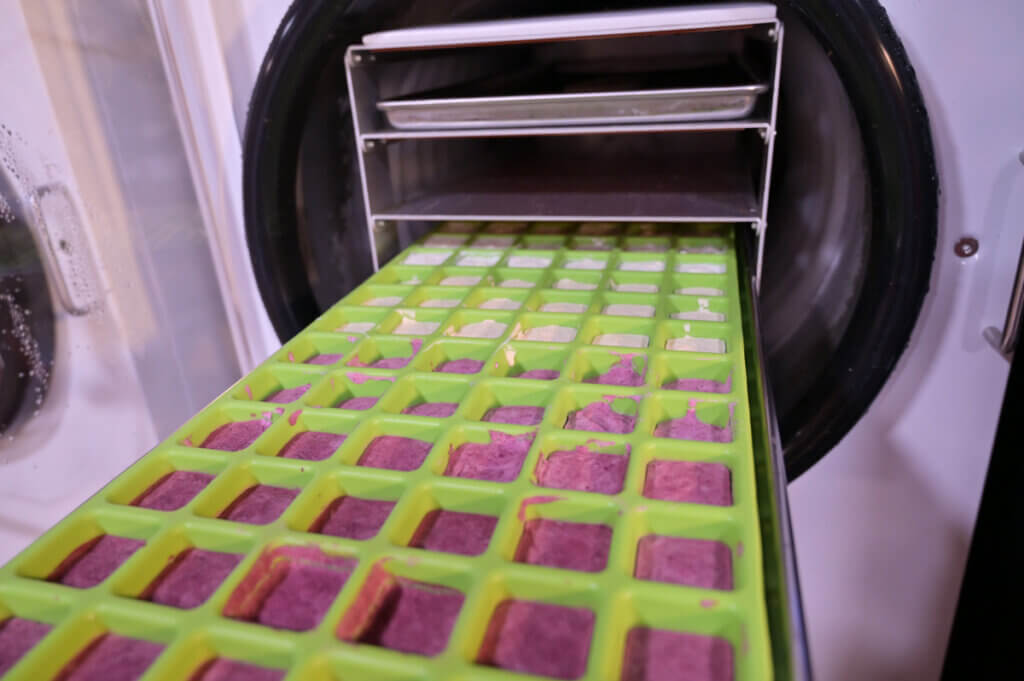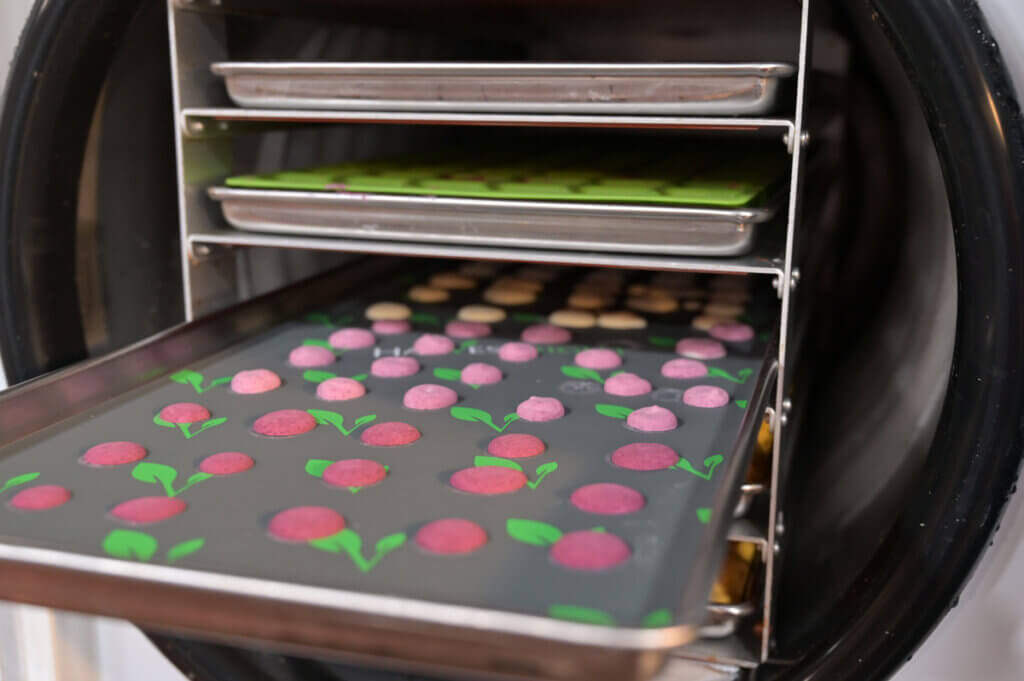Looking for a portable snack that satisfies you and your baby alike? You can preserve your culture and make delicious melt-in-your-mouth treats with freeze dried yogurt. Using homemade yogurt, customize the flavor for strawberry, peach, vanilla, and more!

Why I Love Freeze Dried Yogurt
Now that there’s another baby on the homestead, I knew we’d want to make homemade baby food again. And having healthy portable snacks is key! Especially for those long car trips to town.
Freeze dried baby food is gaining popularity among parents who want to provide nutritious meals for their little ones without sacrificing convenience. Making homemade freeze dried yogurt means I can control the ingredients that go into this healthy snack, and feel confident in giving them to my kids.
There are a few things to learn before you purchase a home freeze dryer. First, it’s important to understand the difference between freeze dried and dehydrated foods, and while the possibilities for this amazing machine seem endless, there are a few foods that should not be freeze dried.
Fortunately, yogurt is not one of these foods. Owning a dairy cow requires us to learn how to make homemade dairy products practical, and learning various ways to preserve raw milk ensures none of it goes to waste.
Making freeze dried yogurt not only extends the shelf life of our homemade yogurt; it also makes a portable snack the whole family can enjoy, and it provides a shelf-stable culture to use when I’m ready to make another batch of fresh yogurt.

Is Freeze Dried Yogurt Good for You?
If you asked me if freeze dried yogurt is good for you, I would say, “It depends!” The freeze drying process does not change an unhealthy product into a nutritious one. The key to remember with any food you preserve is to start with quality ingredients.
While many commercially prepared yogurts contain beneficial probiotics, calcium and protein, they are also often filled with unnecessary additives that offset the benefits of the product.
For instance, the most popular brand of vanilla yogurt contains over a tablespoon of refined sugar per serving as well as questionable ingredients like gums to improve the texture of what is truly an inferior product.
However, homemade yogurt has two simple ingredients: milk and cultures. If you like make flavored or sweetened yogurt, you have the flexibility to choose ingredients that have nutritional value, such as fruits, berries, spices, pumpkin, honey, and maple syrup.
If you choose to sweeten your yogurt, I recommend doing so after you reconstitute your yogurt. Sugars bind to water, making it difficult to freeze dry. However, feel free to flavor your yogurt before freeze drying. Fresh fruit pulverized and added to the yogurt works well.
Can You Freeze Dry Greek Yogurt
Greek yogurt yields a stronger flavor and less desirable texture. Some have experimented with adding a package of gelatin or pudding mix to Greek yogurt in order to improve the flavor and texture. However, I have not tried this myself so I cannot speak to how well it works.

Ways to Use Freeze Dried Yogurt
Although you can eat freeze dried yogurt bites as a stand-alone snack, there are many other ways to enjoy freeze dried yogurt.
- Smoothies – Freeze dried yogurt in your favorite green smoothie adds a creamy texture, a delicious tangy flavor, and probiotics to boost your immune system naturally. Homesteading Hack: You can use this DIY greens powder in your smoothie for even more immune-building health benefits.
- Hot Cereal – We value the importance of a healthy breakfast, and freeze dried yogurt goes well with this healthy instant breakfast mix; just add water!
- Snacks on the Go – Freeze dried yogurt bites, freeze dried berries, and freeze dried apples are a great addition to trail mix for backpacking or to eat on the road when traveling.
- Babies – Our babies love the freeze dried yogurt bites. Making them ourselves ensures they are sugar-free and healthy. They dissolve in your mouth and are delicious!
- Yogurt Culture Backup – Who hasn’t forgotten to reserve a yogurt culture to make a new batch of yogurt? When you have freeze dried yogurt on hand, you never have to worry about it again!
- Cream Cheese Substitute – Rehydrating the yogurt with a low volume of water creates a delicious cream cheese substitute that is fantastic in dips or flavored and used as a spread!
- Yogurt Powder – Use a food processor to make your finished freeze dried yogurt into a powder and add the powder to baked goods or flavor other foods.

How to Make Freeze Dried Yogurt
Supplies Needed
- Freeze Dryer – If you are in the market for a freeze dryer, you should read my honest Harvest Right freeze dryer review before purchasing one (spoiler alert, you’ll learn why we now have TWO!).
- Parchment Paper – It is optional to line the tray with parchment paper, but it can make removing the finished product easier. Homesteading Hack: Harvest Right makes reusable silicone mats that work well too. We use them every time we freeze dry, just to be safe. I’d rather use them unnecessarily than have my food stick.
- Utensils – You will need a rubber spatula for spreading, measuring spoons, and even a varying-sized cookie scoop to transfer the yogurt to the freeze dryer trays.
- Silicone Mold – Harvest Right makes silicone molds that measure one tablespoon, which is perfect for bite-sized treats and easy measuring for a new starter culture. Homesteading Hack: You can also pipe individual drops using a pastry bag or a ziptop storage bag with one corner cut off.
- Deep Freezer – For best results, the yogurt should harden in a deep freezer before freeze drying. If you don’t have a deep freezer, that’s okay; just try to keep the freezer door shut as much as possible.
- Saran Wrap – Covering the yogurt while it’s in the deep freezer will protect it from absorbing other odors.
- Spatula – A spatula makes removing the finished product from the trays smooth and simple.
- Storage Containers – I recommend vacuum-sealing Mason jars or using Mylar bags with an oxygen absorber for long-term storage. Check out this jar sealer, which makes resealing jars a snap. And read this post on how to use oxygen absorbers here.
- Marking Pen and Labels – Always label items with the preservation date and contents to keep track of items in your well-stocked pantry.

Ingredients Needed
- Yogurt – Yogurt is the only ingredient needed for freeze dried yogurt.
- Optional Flavorings – Feel free to add pulverized fruit, spices, or flavored extracts to the yogurt as an added treat.

Step-by-Step Directions
It is important to remember that freeze drying preserves the healthy bacteria that are responsible for the probiotics in yogurt. On that same token, freeze drying does not kill harmful bacteria, so proper handling using clean, food-safe techniques is always important.
- Line freeze dryer trays with parchment paper or silicone mats.
- Transfer the yogurt to the freeze dryer trays using one of the following methods:
- Make individual dollops of yogurt drops with your yogurt-filled pastry bag (or ziptop plastic bag with a hole cut in one corner.)
- Spread the yogurt in a layer across the tray about ½” thick.
- Spoon yogurt into silicone molds with a spoon or cookie scoop to the desired measurement.
- Cover trays with plastic wrap and place trays in a freezer for at least 2 hours and up to 24 hours for best results.
- Prepare your freeze dryer at the recommended temperature before removing the yogurt from the freezer.
- Remove trays from the freezer and discard plastic wrap.
- Load the trays in the freeze dryer, put the insulating cover in place, and close the door. (Note: Newer freeze dryer models no longer come with the insulating cover.)
- Set the timer for 20 hours, checking when the beeper goes off. If it’s not fully freeze dried, return it to the freeze dryer for 2-hour increments until fully freeze dried.

How to Tell If Freeze Dried Yogurt Is Done
The freeze drying process will vary depending on several factors, such as which freeze drying machines are used, the thickness of the product, the amount of moisture originally in the product, how cold the product was at the beginning of the cycle, etc.
It’s important to always test your freeze dried products before packaging them for long-term storage to ensure they’re completely dry. When the freeze dryer has completed its cycle, remove the trays, choose the largest piece of yogurt, and break it in half.
The yogurt should be almost weightless, and the texture similar to styrofoam. The yogurt should not feel cold to the touch; if so, that means there’s still moisture in the yogurt. Return the trays back into the freeze dryer, add more drying time, and recheck them in a couple of hours.
Homesteading Hack: Wait to shut down your freeze dryer until you have confirmed that the yogurt does not need extra drying time.


How to Rehydrate Freeze Dried Yogurt
You can simply pop the freeze dried yogurt drops into your mouth for rehydration; they are so delicious!
When rehydrating for a recipe or to eat in a bowl for breakfast, slowly add cold water, making sure it’s the consistency you want. Remember, you can always add more water, but you can’t remove it if it’s too soupy.
If you want to add them to a cake or muffin batter to add a moist, rich flavor, just put it in the batter and add a bit more liquid if it’s too thick. A little goes a long way!
You can be exact about this by weighing your yogurt before freeze drying and again after freeze drying. The difference between the two weights is how much water (by weight) you want to add back to properly rehydrate the yogurt. The final thickness of the yogurt is a personal preference!

How to Store Freeze Dried Yogurt
For long-term storage, freeze dried yogurt must be kept in airtight containers out of direct sunlight. I recommend using Mason jars with a vacuum sealer or Mylar bags with an oxygen absorber.
If you use the yogurt frequently, I recommend storing it in smaller jars and re-vacuum sealing it each time you open it. Oxygen is the enemy of freeze dried food, so remember your oxygen absorbers. Make sure to label your food with the date and food you freeze dried.
Did you try freeze drying yogurt? If so, please leave a star rating in the recipe card below, then snap a photo of your freeze dried yogurt and tag us on social media @homesteadingfamily so we can see!

Maximizing Your Freeze Dryer
Have you ever wondered what else you can preserve with a freeze dryer?
I reveal the answer to this and so much more in my book Freeze Drying the Harvest: Preserving Food the Modern Way and my Freeze Drying Masterclass. From wild game to watermelon and milk to mashed potatoes — you’ll learn the ins and outs of preserving more food than you thought possible.
These resources can be purchased separately or as companions, so whether you choose the book or the masterclass, you will receive all the information you need to gain the confidence and skills you need to preserve meat, eggs, veggies, fruit, herbs — and yes, even lattes!

Other Articles You May Enjoy
- Easy Instant Pot Yogurt Recipe (Step-by-Step)
- What Is the Best Harvest Right Freeze Dryer For You?
- Freeze Dried vs. Dehydrated Foods – What’s the Difference?
- What Foods Cannot Be Freeze Dried
- Freeze Drying Berries (Easy Snack + Stores for Years)
- How to Freeze Dry Ice Cream
- How to Freeze Dry Candy: Easy Step-by-Step Guide
- Making Homemade Dairy Products Practical


















